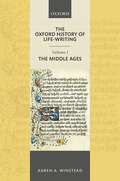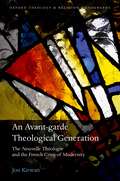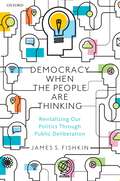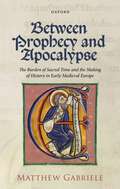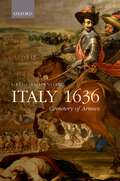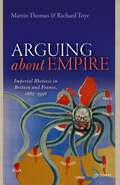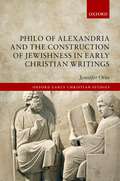- Table View
- List View
Kingship, Society, and the Church in Anglo-Saxon Yorkshire (Medieval History and Archaeology)
by Thomas PicklesInspired by studies of Carolingian Europe, Kingship, Society and the Church in Anglo-Saxon Yorkshire argues that the social strategies of local kin-groups drove conversion to Christianity and church building in Yorkshire from 400-1066 AD. It challenges the emphasis that has been placed on the role and agency of Anglo-Saxon kings in conversion and church building, and moves forward the debate surrounding the 'minster hypothesis' through an inter-disciplinary case study. Members of Deiran kin-groups faced uncertainties that predisposed them to consider conversion as a social strategy, in their rule between 600 and 867. Their decision to convert produced a new social fraction - the 'ecclesiastical aristocracy' - with a distinctive but fragile identity. The 'ecclesiastical aristocracy' transformed kingship, established a network of religious communities, and engaged in the conversion of the laity. The social and political instabilities produced by conversion along with the fragility of ecclesiastical identity resulted in the expropriation and re-organization of many religious communities. Nevertheless, the Scandinavian and West Saxon kings and their nobles allied with wealthy and influential archbishops of York, and there is evidence for the survival, revival, or foundation of religious communities as well as the establishment of local churches.
The Oxford History of Life-Writing: Volume 1. The Middle Ages (Oxford History of Life-Writing)
by Karen A. WinsteadThe Oxford History of Life-Writing: Volume 1: The Middle Ages explores the richness and variety of life-writing from late Antiquity to the threshold of the Renaissance. During the Middle Ages, writers from Bede to Chaucer were thinking about life and experimenting with ways to translate lives, their own and others', into literature. Their subjects included career religious, saints, celebrities, visionaries, pilgrims, princes, philosophers, poets, and even a few 'ordinary people.' They relay life stories not only in chronological narratives, but also in debates, dialogues, visions, and letters. Many medieval biographers relied on the reader's trust in their authority, but some espoused standards of evidence that seem distinctly modern, drawing on reliable written sources, interviewing eyewitnesses, and cross-checking their facts wherever possible. Others still professed allegiance to evidence but nonetheless freely embellished and invented not only events and dialogue but the sources to support them. The first book devoted to life-writing in medieval England, The Oxford History of Life-Writing: Volume 1: The Middle Ages covers major life stories in Old and Middle English, Latin, and French, along with such Continental classics as the letters of Abelard and Heloise and the autobiographical Vision of Christine de Pizan. In addition to the life stories of historical figures, it treats accounts of fictional heroes, from Beowulf to King Arthur to Queen Katherine of Alexandria, which show medieval authors experimenting with, adapting, and expanding the conventions of life writing. Though Medieval life writings can be challenging to read, we encounter in them the antecedents of many of our own diverse biographical forms-tabloid lives, literary lives, brief lives, revisionist lives; lives of political figures, memoirs, fictional lives, and psychologically-oriented accounts that register the inner lives of their subjects.
Imagining the Woman Reader in the Age of Dante
by Elena LombardiImagining the Woman Reader in the Age of Dante brings to light a new character in medieval literature: that of the woman reader and interlocutor. It does so by establishing a dialogue between literary studies, gender studies, the history of literacy, and the material culture of the book in medieval times. From Guittone d'Arezzo's piercing critic, the 'villainous woman', to the mysterious Lady who bids Guido Cavalcanti to write his grand philosophical song, to Dante's female co-editors in the Vita Nova and his great characters of female readers, such as Francesca and Beatrice in the Comedy, all the way to Boccaccio's overtly female audience, this particular interlocutor appears to be central to the construct of textuality and the construction of literary authority. This volume explores the figure of the woman reader by contextualizing her within the history of female literacy, the material culture of the book, and the ways in which writers and poets of earlier traditions imagined her. It argues that these figures are not mere veneers between a male author and a 'real' male readership, but that, although fictional, they bring several advantages to their vernacular authors, such as orality, the mother tongue, the recollection of the delights of early education, literality, freedom in interpretation, absence of teleology, the beauties of ornamentation and amplification, a reduced preoccupation with the fixity of the text, the pleasure of making mistakes, dialogue with the other, the extension of desire, original simplicity, and new and more flexible forms of authority.
Imagining the Woman Reader in the Age of Dante
by Elena LombardiImagining the Woman Reader in the Age of Dante brings to light a new character in medieval literature: that of the woman reader and interlocutor. It does so by establishing a dialogue between literary studies, gender studies, the history of literacy, and the material culture of the book in medieval times. From Guittone d'Arezzo's piercing critic, the 'villainous woman', to the mysterious Lady who bids Guido Cavalcanti to write his grand philosophical song, to Dante's female co-editors in the Vita Nova and his great characters of female readers, such as Francesca and Beatrice in the Comedy, all the way to Boccaccio's overtly female audience, this particular interlocutor appears to be central to the construct of textuality and the construction of literary authority. This volume explores the figure of the woman reader by contextualizing her within the history of female literacy, the material culture of the book, and the ways in which writers and poets of earlier traditions imagined her. It argues that these figures are not mere veneers between a male author and a 'real' male readership, but that, although fictional, they bring several advantages to their vernacular authors, such as orality, the mother tongue, the recollection of the delights of early education, literality, freedom in interpretation, absence of teleology, the beauties of ornamentation and amplification, a reduced preoccupation with the fixity of the text, the pleasure of making mistakes, dialogue with the other, the extension of desire, original simplicity, and new and more flexible forms of authority.
An Avant-garde Theological Generation: The Nouvelle Théologie and the French Crisis of Modernity (Oxford Theology and Religion Monographs)
by Jon KirwanAn Avant-garde Theological Generation examines the Fourvière Jesuits and Le Saulchoir Dominicans, theologians and philosophers who comprised the influential reform movement the nouvelle théologie. Led by Henri de Lubac, Jean Daniélou, Yves Congar, and Marie-Dominique Chenu, the movement flourished from the 1930s until its suppression in 1950. It aims to remedy certain historical deficiencies by constructing a history both sensitive to the wider intellectual, political, economic, and cultural milieu of the French interwar crisis, and that establishes continuity with the Modernist crisis and the First World War. Chapter One examines the modern French avant-garde generations that have shaped intellectual and political thought in France, providing context for a historical narrative of the nouvelle théologie. Chapters Two and Three examine the influential older generations that flourished from 1893 to 1914, such as the Dreyfus generation, the generation of Catholic Modernists, and two generations of older Jesuits and Dominicans, which were instrumental in the Fourvière Jesuits' development. Chapter Four explores the influence of the First World War and the years of the 1920s, during which the Jesuits and Dominicans were in religious and intellectual formation, relying heavily on unpublished letters and documents from the Jesuits archives in Paris (Vanves). Chapter Five analyses the crises of the interwar period and the emergence of the wider generation of 1930—to which the nouveaux théologiens belonged—and its intellectual thirst for revolution. Chapter Six examines the emergence of the ^ ressourcement thinkers during the tumultuous years of the 1930s. The decade of the 1940s, explored in Chapter Seven, saw the rise to prominence of the members of the generation of 1930, who, thanks to their participation in the resistance, emerged from the Second World War, with significant influence on the postwar French intellectual milieu. Finally, the monograph concludes in Chapter Eight with an examination of the triumph of French Left Catholicism and the nouvelle théologie during the 1960s at the Second Vatican Council.
An Avant-garde Theological Generation: The Nouvelle Théologie and the French Crisis of Modernity (Oxford Theology and Religion Monographs)
by Jon KirwanAn Avant-garde Theological Generation examines the Fourvière Jesuits and Le Saulchoir Dominicans, theologians and philosophers who comprised the influential reform movement the nouvelle théologie. Led by Henri de Lubac, Jean Daniélou, Yves Congar, and Marie-Dominique Chenu, the movement flourished from the 1930s until its suppression in 1950. It aims to remedy certain historical deficiencies by constructing a history both sensitive to the wider intellectual, political, economic, and cultural milieu of the French interwar crisis, and that establishes continuity with the Modernist crisis and the First World War. Chapter One examines the modern French avant-garde generations that have shaped intellectual and political thought in France, providing context for a historical narrative of the nouvelle théologie. Chapters Two and Three examine the influential older generations that flourished from 1893 to 1914, such as the Dreyfus generation, the generation of Catholic Modernists, and two generations of older Jesuits and Dominicans, which were instrumental in the Fourvière Jesuits' development. Chapter Four explores the influence of the First World War and the years of the 1920s, during which the Jesuits and Dominicans were in religious and intellectual formation, relying heavily on unpublished letters and documents from the Jesuits archives in Paris (Vanves). Chapter Five analyses the crises of the interwar period and the emergence of the wider generation of 1930—to which the nouveaux théologiens belonged—and its intellectual thirst for revolution. Chapter Six examines the emergence of the ^ ressourcement thinkers during the tumultuous years of the 1930s. The decade of the 1940s, explored in Chapter Seven, saw the rise to prominence of the members of the generation of 1930, who, thanks to their participation in the resistance, emerged from the Second World War, with significant influence on the postwar French intellectual milieu. Finally, the monograph concludes in Chapter Eight with an examination of the triumph of French Left Catholicism and the nouvelle théologie during the 1960s at the Second Vatican Council.
Epidemics: Hate and Compassion from the Plague of Athens to AIDS
by Samuel K. Cohn, Jr.By investigating thousands of descriptions of epidemics reaching back before the fifth-century-BCE Plague of Athens to the distrust and violence that erupted with Ebola in 2014, Epidemics challenges a dominant hypothesis in the study of epidemics, that invariably across time and space, epidemics provoked hatred, blaming of the 'other', and victimizing bearers of epidemic diseases, particularly when diseases were mysterious, without known cures or preventive measures, as with AIDS during the last two decades of the twentieth century. However, scholars and public intellectuals, especially post-AIDS, have missed a fundamental aspect of the history of epidemics. Instead of sparking hatred and blame, this study traces epidemics' socio-psychological consequences across time and discovers a radically different picture: that epidemic diseases have more often unified societies across class, race, ethnicity, and religion, spurring self-sacrifice and compassion.
Epidemics: Hate and Compassion from the Plague of Athens to AIDS
by Samuel K. Cohn, Jr.By investigating thousands of descriptions of epidemics reaching back before the fifth-century-BCE Plague of Athens to the distrust and violence that erupted with Ebola in 2014, Epidemics challenges a dominant hypothesis in the study of epidemics, that invariably across time and space, epidemics provoked hatred, blaming of the 'other', and victimizing bearers of epidemic diseases, particularly when diseases were mysterious, without known cures or preventive measures, as with AIDS during the last two decades of the twentieth century. However, scholars and public intellectuals, especially post-AIDS, have missed a fundamental aspect of the history of epidemics. Instead of sparking hatred and blame, this study traces epidemics' socio-psychological consequences across time and discovers a radically different picture: that epidemic diseases have more often unified societies across class, race, ethnicity, and religion, spurring self-sacrifice and compassion.
Hunger in War and Peace: Women and Children in Germany, 1914-1924 (Oxford Historical Monographs)
by Mary Elisabeth CoxAt the outbreak of the First World War, Great Britain quickly took steps to initiate a naval blockade against Germany. In addition to military goods and other contraband, foodstuffs and fertilizer were also added to the list of forbidden exports to Germany. As the grip of the Blockade strengthened, Germans complained that civilians-particularly women and children-were going hungry because of it. The impact of the blockade on non-combatants was especially fraught during the eight month period of the Armistice when the blockade remained in force. Even though fighting had stopped, German civilians wondered how they would go through another winter of hunger. The issue became internationalised as civic leaders across the country wrote books, pamphlets, and articles about their distress, and begged for someone to step in and relieve German women and children with food aid. Their pleas were answered with an outpouring of generosity from across the world. Some have argued, then and since, that these outcries were based on gross exaggerations based more on political need rather than actual want. This book examines what the actual nutritional statuses of women and children in Germany were during and following the War. Mary Cox uses detailed height and weight data for over 600,000 German children to show the true measure of overall deprivation, and to gauge infant recovery.
Hunger in War and Peace: Women and Children in Germany, 1914-1924 (Oxford Historical Monographs)
by Mary Elisabeth CoxAt the outbreak of the First World War, Great Britain quickly took steps to initiate a naval blockade against Germany. In addition to military goods and other contraband, foodstuffs and fertilizer were also added to the list of forbidden exports to Germany. As the grip of the Blockade strengthened, Germans complained that civilians-particularly women and children-were going hungry because of it. The impact of the blockade on non-combatants was especially fraught during the eight month period of the Armistice when the blockade remained in force. Even though fighting had stopped, German civilians wondered how they would go through another winter of hunger. The issue became internationalised as civic leaders across the country wrote books, pamphlets, and articles about their distress, and begged for someone to step in and relieve German women and children with food aid. Their pleas were answered with an outpouring of generosity from across the world. Some have argued, then and since, that these outcries were based on gross exaggerations based more on political need rather than actual want. This book examines what the actual nutritional statuses of women and children in Germany were during and following the War. Mary Cox uses detailed height and weight data for over 600,000 German children to show the true measure of overall deprivation, and to gauge infant recovery.
The Scythians: Nomad Warriors of the Steppe
by Barry CunliffeBrilliant horsemen and great fighters, the Scythians were nomadic horsemen who ranged wide across the grasslands of the Asian steppe from the Altai mountains in the east to the Great Hungarian Plain in the first millennium BC. Their steppe homeland bordered on a number of sedentary states to the south - the Chinese, the Persians and the Greeks - and there were, inevitably, numerous interactions between the nomads and their neighbours. The Scythians fought the Persians on a number of occasions, in one battle killing their king and on another occasion driving the invading army of Darius the Great from the steppe. Relations with the Greeks around the shores of the Black Sea were rather different - both communities benefiting from trading with each other. This led to the development of a brilliant art style, often depicting scenes from Scythian mythology and everyday life. It is from the writings of Greeks like the historian Herodotus that we learn of Scythian life: their beliefs, their burial practices, their love of fighting, and their ambivalent attitudes to gender. It is a world that is also brilliantly illuminated by the rich material culture recovered from Scythian burials, from the graves of kings on the Pontic steppe, with their elaborate gold work and vividly coloured fabrics, to the frozen tombs of the Altai mountains, where all the organic material - wooden carvings, carpets, saddles and even tattooed human bodies - is amazingly well preserved. Barry Cunliffe here marshals this vast array of evidence - both archaeological and textual - in a masterful reconstruction of the lost world of the Scythians, allowing them to emerge in all their considerable vigour and splendour for the first time in over two millennia.
The Scythians: Nomad Warriors of the Steppe
by Barry CunliffeBrilliant horsemen and great fighters, the Scythians were nomadic horsemen who ranged wide across the grasslands of the Asian steppe from the Altai mountains in the east to the Great Hungarian Plain in the first millennium BC. Their steppe homeland bordered on a number of sedentary states to the south - the Chinese, the Persians and the Greeks - and there were, inevitably, numerous interactions between the nomads and their neighbours. The Scythians fought the Persians on a number of occasions, in one battle killing their king and on another occasion driving the invading army of Darius the Great from the steppe. Relations with the Greeks around the shores of the Black Sea were rather different - both communities benefiting from trading with each other. This led to the development of a brilliant art style, often depicting scenes from Scythian mythology and everyday life. It is from the writings of Greeks like the historian Herodotus that we learn of Scythian life: their beliefs, their burial practices, their love of fighting, and their ambivalent attitudes to gender. It is a world that is also brilliantly illuminated by the rich material culture recovered from Scythian burials, from the graves of kings on the Pontic steppe, with their elaborate gold work and vividly coloured fabrics, to the frozen tombs of the Altai mountains, where all the organic material - wooden carvings, carpets, saddles and even tattooed human bodies - is amazingly well preserved. Barry Cunliffe here marshals this vast array of evidence - both archaeological and textual - in a masterful reconstruction of the lost world of the Scythians, allowing them to emerge in all their considerable vigour and splendour for the first time in over two millennia.
The Emergence of the Fourth Dimension: Higher Spatial Thinking in the Fin de Siècle
by Mark BlacklockThe Emergence of the Fourth Dimension describes the development and proliferation of the idea of higher dimensional space in the late nineteenth- and early twentieth-centuries. An idea from mathematics that was appropriated by occultist thought, it emerged in the fin de siècle as a staple of genre fiction and influenced a number of important Modernist writers and artists. Providing a context for thinking of space in dimensional terms, the volume describes an active interplay between self-fashioning disciplines and a key moment in the popularisation of science. It offers new research into spiritualism and the Theosophical Society and studies a series of curious hybrid texts. Examining works by Joseph Conrad, Ford Madox Ford, H.G. Wells, Henry James, H. P. Lovecraft, and others, the volume explores how new theories of the possibilities of time and space influenced fiction writers of the period, and how literature shaped, and was in turn shaped by, the reconfiguration of imaginative space occasioned by the n-dimensional turn. A timely study of the interplay between philosophy, literature, culture, and mathematics, it offers a rich resource for readers interested in nineteenth century literature, Modernist studies, science fiction, and gothic scholarship.
Democracy When the People Are Thinking: Revitalizing Our Politics Through Public Deliberation
by James S. FishkinDemocracy requires a connection to the 'will of the people'. What does that mean in a world of 'fake news', relentless advocacy, dialogue mostly among the like-minded, and massive spending to manipulate public opinion? What kind of opinion can the public have under such conditions? What would democracy be like if the people were really thinking in depth about the policies they must live with? If they really 'deliberated' with good information about their political choices? This book argues that 'deliberative democracy' is not utopian. It is a practical solution to many of democracy's ills. It can supplement existing institutions with practical reforms. It can apply at all levels of government and for many different kinds of policy choices. This volume speaks to a recurring dilemma: listen to the people and get the angry voices of populism or rely on widely distrusted elites and get policies that seem out of touch with the public's concerns. Instead, there are methods for getting a representative and thoughtful public voice that is really worth listening to. Democracy is under siege in most countries, where democratic institutions have low approval and face a resurgent threat from authoritarian regimes. Deliberative democracy can provide an antidote and can reinvigorate our democratic politics. Democracy When the People Are Thinking draws on the author's research with many collaborators on 'Deliberative Polling'-a process conducted in 27 countries on six continents. It contributes both to political theory and to the empirical study of public opinion and participation. It should interest anyone concerned about the future of democracy and how it can be revitalized.
Democracy When the People Are Thinking: Revitalizing Our Politics Through Public Deliberation
by James S. FishkinDemocracy requires a connection to the 'will of the people'. What does that mean in a world of 'fake news', relentless advocacy, dialogue mostly among the like-minded, and massive spending to manipulate public opinion? What kind of opinion can the public have under such conditions? What would democracy be like if the people were really thinking in depth about the policies they must live with? If they really 'deliberated' with good information about their political choices? This book argues that 'deliberative democracy' is not utopian. It is a practical solution to many of democracy's ills. It can supplement existing institutions with practical reforms. It can apply at all levels of government and for many different kinds of policy choices. This volume speaks to a recurring dilemma: listen to the people and get the angry voices of populism or rely on widely distrusted elites and get policies that seem out of touch with the public's concerns. Instead, there are methods for getting a representative and thoughtful public voice that is really worth listening to. Democracy is under siege in most countries, where democratic institutions have low approval and face a resurgent threat from authoritarian regimes. Deliberative democracy can provide an antidote and can reinvigorate our democratic politics. Democracy When the People Are Thinking draws on the author's research with many collaborators on 'Deliberative Polling'-a process conducted in 27 countries on six continents. It contributes both to political theory and to the empirical study of public opinion and participation. It should interest anyone concerned about the future of democracy and how it can be revitalized.
The Politics of Humiliation: A Modern History
by Ute FrevertIn a brilliant procession through the last 250 years, Ute Frevert looks at the role that public humiliation has played in modern society, showing how humiliation - and the feeling of shame that it engenders - has been used as a means of coercion and control, from the worlds of politics and international diplomacy through to the education of children and the administration of justice. We learn the stories of the French women whose hair was compulsorily shaven as a punishment for alleged relations with German soldiers during the occupation of France, and of the transgressors in the USA who are made to carry a sign announcing their presence when walking down busy streets. Bringing the story right up to the present, we see how the internet and social media pillorying have made public shaming a ubiquitous phenomenon. Using a multitude of both historical and contemporary examples, Ute Frevert shows how humiliation has been used as a tool over the last 250 years (and how it still is today), a story that reveals remarkable similarities across different times and places. And we see how the art of humiliation is in no way a thing of the past but has been re-invented for the 21st century, in a world where such humiliation is inflicted not from above by the political powers that be but by our social peers.
The Politics of Humiliation: A Modern History
by Ute FrevertIn a brilliant procession through the last 250 years, Ute Frevert looks at the role that public humiliation has played in modern society, showing how humiliation - and the feeling of shame that it engenders - has been used as a means of coercion and control, from the worlds of politics and international diplomacy through to the education of children and the administration of justice. We learn the stories of the French women whose hair was compulsorily shaven as a punishment for alleged relations with German soldiers during the occupation of France, and of the transgressors in the USA who are made to carry a sign announcing their presence when walking down busy streets. Bringing the story right up to the present, we see how the internet and social media pillorying have made public shaming a ubiquitous phenomenon. Using a multitude of both historical and contemporary examples, Ute Frevert shows how humiliation has been used as a tool over the last 250 years (and how it still is today), a story that reveals remarkable similarities across different times and places. And we see how the art of humiliation is in no way a thing of the past but has been re-invented for the 21st century, in a world where such humiliation is inflicted not from above by the political powers that be but by our social peers.
Between Prophecy and Apocalypse: The Burden of Sacred Time and the Making of History in Early Medieval Europe
by Matthew GabrieleThe tenth and eleventh centuries in medieval Europe are commonly seen as a time of uncertainty and loss: an age of lawless aristocrats, of weak political authority, of cultural decline and dissolute monks, and of rampant superstition. It is a period often judged from its margins, compared (mostly negatively) to what came before and what would follow. We impose upon it both a sense of nostalgia and a teleology, as they somehow knowingly foreshadow what is to come. Seeking to complicate this mischaracterisation, which is primarily the invention of nineteenth and early twentieth century historiography, this book maps the movement between two intellectual stances: a shift from prophetic to apocalyptic thinking. Although the roots of this change lay in Late Antiquity, the fulcrum of this transition lies in the tenth and eleventh centuries. Biblical commentators in the fourth and fifth centuries enforced a particular understanding of sacred time that held until the ninth century, when exegetes of the ninth century found in their commentaries a different plan for God's new chosen people. This came into stark relief as the new kingdom of Israel (the Frankish empire under the Carolingians) had splintered in the 840s. God was manifesting his displeasure with the chosen people by fire and sword. What was perhaps unforeseen was that these commentaries that were written in the specific context of the Carolingian Civil War would be heavily copied and read for the next 200 years. Ideas that formed in a world that actively lamented the loss of empire had to be translated to a world that could only dream of that empire. As they spread across Europe, these ideas became the basis for monastic educational practices, and bled into other types of textual production, such as supposedly "secular" histories. Between Prophecy and Apocalypse charts an intellectual transformation triggered when the prescriptions laid out towards the end of the Carolingian empire began to be "realized" in subsequent centuries. Nostalgia entwined with an attentiveness to possible futures and spun together so tightly as to become a double helix. Ultimately, this book will offer a way to understand the central Middle Ages, a period of dynamic intellectual ferment when ideas could inspire action and (seemingly banal) conceptions of time and history could inspire moments of dramatic transformation and horrific violence.
Italy 1636: Cemetery of Armies
by Gregory HanlonItaly 1636 is one of the most closely-researched and detailed books on the operation of early modern armies anywhere, and is explicitly inspired by neo-Darwinian thinking. Taking the French and Savoyard invasion of Spanish Lombardy in 1636 as its specific example, it begins with the recruitment of the soldiers, the care and feeding of the armies and their horses, the impact of the invasion on civilians in the path of their advance, and the manner in which generals conducted their campaign in response to the information at their disposal. The next section describes the unfolding of the long and stubborn battle of Tornavento, where Spanish, German, and Italian soldiers stormed the French in their entrenchments, detailing the tactics of both the infantry and the cavalry, and re-evaluating the effectiveness of Spanish methods in the 1630s. The account focuses on the motivations of soldiers to fight, and how they reacted to the stress of combat. Gregory Hanlon arrives at surprising conclusions on the conditions under which they were ready to kill their adversaries, and when they were content to intimidate them into retiring. The volume concludes by examining the penchant for looting of the soldiery in the aftermath of battle, the methods of treating wounded soldiers in the Milan hospital, the horrific consequences of hygienic breakdown in the French camp, and the strategic failure of the invasion in the aftermath of battle. This in turn underscores the surprising resilience of Spanish policies and Spanish arms in Europe. In describing with painstaking detail the invasion of 1636, Hanlon explores the universal features of human behaviour and psychology as they relate to violence and war.
Shaping the Geography of Empire: Man and Nature in Herodotus' Histories
by Katherine ClarkeThis volume explores the spatial framework of Herodotus' Histories, the Greek historian's account of Persian imperialism in the sixth and fifth century BC and its culmination in a series of grand expeditions against Greece itself. Focusing on his presentation of the natural world through careful geographical descriptions, ranging from continents and river and mountain networks on a vast scale down to the local settings for individual episodes, it also examines how these landscapes are charged with greater depth and resonance through Herodotus' use of mythological associations and spatial parallels. Man's interaction with, and alteration of, the physical world of the Histories adds another critical dimension to the meaning given to space in Herodotus' work, as his subjects' own agency serves to transform their geography from a neutral backdrop into a resonant landscape with its own role to play in the narrative, in turn reinforcing the placing of the protagonists along a spectrum of positive or negative characterizations. The Persian imperial bid may thus be seen as a war on nature, no less than on their intended subjects: however, as Herodotus reflects, Greece itself is waiting in the wings with the potential to be no less abusive an imperial power. Although the multi-vocal nature of the narrative complicates whether we can identify a 'Herodotean' world at all, still less one in which moral judgements are consistently cast, the fluid and complex web of spatial relationships revealed in discussion nevertheless allows focalization to be brought productively into play, demonstrating how the world of the Histories may be viewed from multiple perspectives. What emerges from the multiple worlds and world-views that Herodotus creates in his narrative is the mutability of fortune that allows successive imperial powers to dominate: as the exercise of political power is manifested both metaphorically and literally through control over the natural world, the map of imperial geography is constantly in flux.
Shaping the Geography of Empire: Man and Nature in Herodotus' Histories
by Katherine ClarkeThis volume explores the spatial framework of Herodotus' Histories, the Greek historian's account of Persian imperialism in the sixth and fifth century BC and its culmination in a series of grand expeditions against Greece itself. Focusing on his presentation of the natural world through careful geographical descriptions, ranging from continents and river and mountain networks on a vast scale down to the local settings for individual episodes, it also examines how these landscapes are charged with greater depth and resonance through Herodotus' use of mythological associations and spatial parallels. Man's interaction with, and alteration of, the physical world of the Histories adds another critical dimension to the meaning given to space in Herodotus' work, as his subjects' own agency serves to transform their geography from a neutral backdrop into a resonant landscape with its own role to play in the narrative, in turn reinforcing the placing of the protagonists along a spectrum of positive or negative characterizations. The Persian imperial bid may thus be seen as a war on nature, no less than on their intended subjects: however, as Herodotus reflects, Greece itself is waiting in the wings with the potential to be no less abusive an imperial power. Although the multi-vocal nature of the narrative complicates whether we can identify a 'Herodotean' world at all, still less one in which moral judgements are consistently cast, the fluid and complex web of spatial relationships revealed in discussion nevertheless allows focalization to be brought productively into play, demonstrating how the world of the Histories may be viewed from multiple perspectives. What emerges from the multiple worlds and world-views that Herodotus creates in his narrative is the mutability of fortune that allows successive imperial powers to dominate: as the exercise of political power is manifested both metaphorically and literally through control over the natural world, the map of imperial geography is constantly in flux.
Accounting for Oneself: Worth, Status, and the Social Order in Early Modern England
by Alexandra ShepardAccounting for Oneself is a major new study of the social order in early modern England, as viewed and articulated from the bottom up. Engaging with how people from across the social spectrum placed themselves within the social order, it pieces together the language of self-description deployed by over 13,500 witnesses in English courts when answering questions designed to assess their creditworthiness. Spanning the period between 1550 and 1728, and with a broad geographical coverage, this study explores how men and women accounted for their 'worth' and described what they did for a living at differing points in the life-cycle. A corrective to top-down, male-centric accounts of the social order penned by elite observers, the perspective from below testifies to an intricate hierarchy based on sophisticated forms of social reckoning that were articulated throughout the social scale. A culture of appraisal was central to the competitive processes whereby people judged their own and others' social positions. For the majority it was not land that was the yardstick of status but moveable property-the goods and chattels in people's possession ranging from livestock to linens, tools to trading goods, tables to tubs, clothes to cushions. Such items were repositories of wealth and the security for the credit on which the bulk of early modern exchange depended. Accounting for Oneself also sheds new light on women's relationship to property, on gendered divisions of labour, and on early modern understandings of work which were linked as much to having as to getting a living. The view from below was not unchanging, but bears witness to the profound impact of widening social inequality that opened up a chasm between the middle ranks and the labouring poor between the mid-sixteenth and mid-seventeenth centuries. As a result, not only was the social hierarchy distorted beyond recognition, from the later-seventeenth century there was also a gradual yet fundamental reworking of the criteria informing the calculus of esteem.
Arguing about Empire: Imperial Rhetoric in Britain and France, 1882-1956
by Martin Thomas Richard ToyeArguing about Empire analyses the most divisive arguments about empire between Europe's two leading colonial powers from the age of high imperialism to the post-war era of decolonization. Focusing on the domestic contexts underlying imperial rhetoric, Arguing about Empire adopts a case-study approach, treating key imperial debates as historical episodes to be investigated in depth. The episodes in question have been selected both for their chronological range, their variety, and, above all, their vitriol. Some were straightforward disputes; others involved cooperation in tense circumstances. These include the Tunisian and Egyptian crises of 1881-2, which saw France and Britain establish new North African protectorates, ostensibly in co-operation, but actually in competition; the Fashoda Crisis of 1898, when Britain and France came to the brink of war in the aftermath of the British re-conquest of Sudan; the Moroccan crises of 1905 and 1911, early tests of the Entente Cordiale, when Britain lent support to France in the face of German threats; the 1922 Chanak crisis, when that imperial Entente broke down in the face of a threatened attack on Franco-British forces by Kemalist Turkey; World War Two, which can be seen in part as an undeclared colonial war between the former allies, complicated by the division of the French Empire between De Gaulle's Free French forces and those who remained loyal to the Vichy Regime; and finally the 1956 Suez intervention, when, far from defusing another imperial crisis, Britain colluded with France and Israel to invade Egypt — the culmination of the imperial interference that began some eighty years earlier.
Philo of Alexandria and the Construction of Jewishness in Early Christian Writings (Oxford Early Christian Studies)
by Jennifer OttoPhilo of Alexandria and the Construction of Jewishness in Early Christian Writings investigates portrayals of the first-century philosopher and exegete Philo of Alexandria, in the writings of Clement of Alexandria, Origen, and Eusebius. It argues that early Christian invocations of Philo are best understood not as attempts simply to claim an illustrious Jew for the Christian fold, but as examples of ongoing efforts to define the continuities and distinctive features of Christian beliefs and practices in relation to those of the Jews. This study takes as its starting point the curious fact that none of the first three Christians to mention Philo refer to him unambiguously as a Jew. Clement, the first in the Christian tradition to openly cite Philo's works, refers to him twice as a Pythagorean. Origen, who mentions Philo by name only three times, makes far more frequent reference to him in the guise of an anonymous "one who came before us." Eusebius, who invokes Philo on many more occasions than does Clement or Origen, most often refers to Philo as a Hebrew. These epithets construct Philo as an alternative "near-other" to both Christians and Jews, through whom ideas and practices may be imported to the former from the latter, all the while establishing boundaries between the "Christian" and "Jewish" ways of life. The portraits of Philo offered by each author reveal ongoing processes of difference-making and difference-effacing that constituted not only the construction of the Jewish "other," but also the Christian "self."
Philo of Alexandria and the Construction of Jewishness in Early Christian Writings (Oxford Early Christian Studies)
by Jennifer OttoPhilo of Alexandria and the Construction of Jewishness in Early Christian Writings investigates portrayals of the first-century philosopher and exegete Philo of Alexandria, in the writings of Clement of Alexandria, Origen, and Eusebius. It argues that early Christian invocations of Philo are best understood not as attempts simply to claim an illustrious Jew for the Christian fold, but as examples of ongoing efforts to define the continuities and distinctive features of Christian beliefs and practices in relation to those of the Jews. This study takes as its starting point the curious fact that none of the first three Christians to mention Philo refer to him unambiguously as a Jew. Clement, the first in the Christian tradition to openly cite Philo's works, refers to him twice as a Pythagorean. Origen, who mentions Philo by name only three times, makes far more frequent reference to him in the guise of an anonymous "one who came before us." Eusebius, who invokes Philo on many more occasions than does Clement or Origen, most often refers to Philo as a Hebrew. These epithets construct Philo as an alternative "near-other" to both Christians and Jews, through whom ideas and practices may be imported to the former from the latter, all the while establishing boundaries between the "Christian" and "Jewish" ways of life. The portraits of Philo offered by each author reveal ongoing processes of difference-making and difference-effacing that constituted not only the construction of the Jewish "other," but also the Christian "self."

